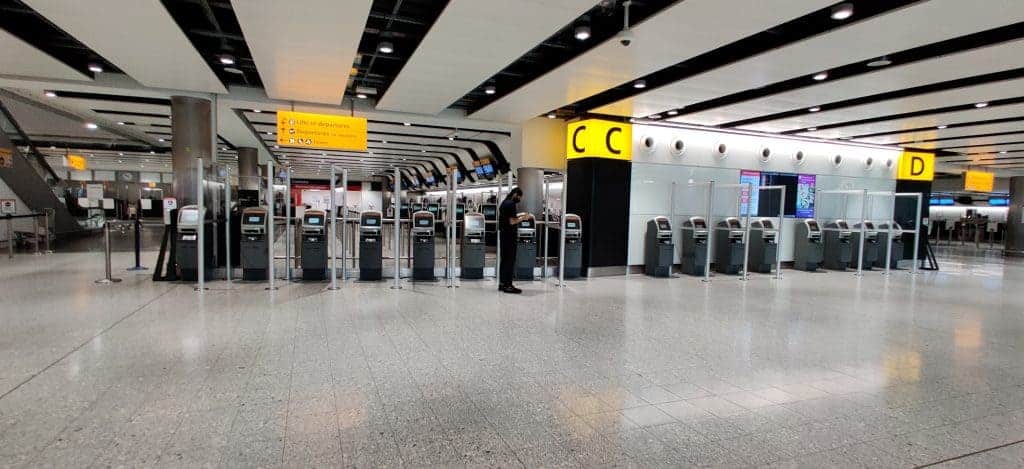 Airports increasingly utilise common-use passenger processing systems (CUPPS) for efficiency and ease of use, for employees and passengers. These systems involve using the same equipment regardless of airline, whereas historically each airline would have its own designated check-in desks and technical systems. With common use equipment, some (or all) airlines share this equipment. CUPPS (Common Use Passenger Processing Systems) was developed as a global standard to progress the use of this technology.
Airports increasingly utilise common-use passenger processing systems (CUPPS) for efficiency and ease of use, for employees and passengers. These systems involve using the same equipment regardless of airline, whereas historically each airline would have its own designated check-in desks and technical systems. With common use equipment, some (or all) airlines share this equipment. CUPPS (Common Use Passenger Processing Systems) was developed as a global standard to progress the use of this technology.
In our work with constrained airports worldwide, we increasingly recommend common use systems to improve efficiency and increase capacity, using the CUPPS standard to ensure integrity and useability.
CUPPS, CUTE and CUSS
The sharing of equipment by airlines is referred to by a number of similar acronyms.
The definition of CUPPS, stated by IATA , is the range of services, specifications, and standards enacted to enable multiple airlines, service providers, or other users to share physical check-in or gate podium positions (simultaneously or consecutively). By using the CUPPS standard, airports have a detailed technical specification that supports current hardware and software, providing a framework for data privacy, consumer privacy, and standards-based statutory and regulatory compliance. This then provides a structured environment for introducing new technologies, as and when they occur.
CUTE, Common Use Terminal Equipment, is the sharing of traditional check-in desks and the software platform to generate the bag tags for baggage handling systems.
CUPPS aims to provide sharing capability across Passenger Processing Platforms based on modern technological advancements, enhancing the CUTE standard which first came about in the 1980s.
CUSS is Common Use Self Service, for the sharing of check-in self-service kiosks. This enables airport operators to take the space that has previously been exclusive to a single airline and make it available for use by multiple airlines and their passengers.
Traditionally, check-in desks are leased and operated by the airline. Each airline check-in agent uses its own software to check in and to generate the bag tags. The new Common Use Technology, under the CUPPS standard, allows all airlines to use their individual apps on the common platform for check-in, and the airport owns the units and equipment.
What are the benefits of CUPPS?
CUPPS reduces the cost for airlines and airports, simplifying procurement, installation, support and ongoing maintenance of passenger processing and operations.
Using the CUPPS standard also offers support and maintenance, as well as facilitating the airport’s transition to common use, from kiosks to boarding controls.
Specifically for our clients, we find that CUPPS, CUTE and CUSS increase asset optimisation and greater flexibility; reduce process time and allow a free-flowing terminal. This benefits all airlines and the airport by contributing to passenger satisfaction.
The new technologies also offer resiliency for operators and create opportunities for future growth, keeping pace with the growing demand and preventing future investment costs.
One perceived disadvantage for implementing CUPPS is engaging stakeholders across the airport, as this reorganisation of assets can only be done with the agreement of many stakeholders. However, our work with airports and their stakeholders to highlight the benefits of these improvements, through data analytics and modelling simulations eases the transition significantly.
How can AiQ help with CUPPS, CUSS and CUTE requirements?
AiQ support airports with all terminal, check-in, passenger automation and baggage analytics to inform on strategic and operational developments. Using our operational airport experience and analytical skills our team run complex calculations to analyse different check-in options, automation systems, layouts and resource requirements to ensure an efficient and optimised operation. Our recommendations are based on surveys and observations we undertake at the airport, analysing passenger, baggage and processing times. Read how we helped Manchester Airport improve the capacity and efficiency of their check-in process.
Contact us
Let us help you with your terminal requirement. Complete the form below for a fast response to your enquiry.

